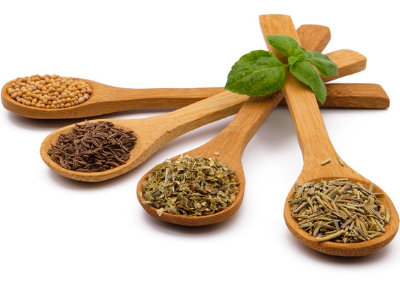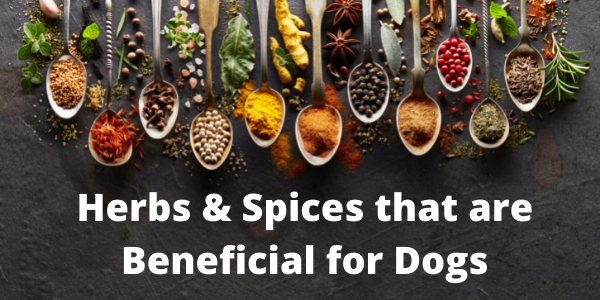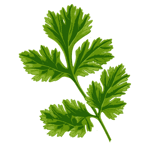
“The secret of happiness is variety, but the secret of variety, like the secret of all spices, is knowing when to use it.” – Daniel Gilbert
The last part of this quote is so important when it comes to our dogs. We pick and choose how we season our foods based on our preferences for sweet and sour or hot and spicy. While many herbs and spices can provide our dogs with benefits, there are some that can be harmful. So, it is important to know what and when to use them and how much of each of these herbs and spices are safe.
If you are a culinary genius or just way more into cooking than I am, you may already know the difference between herbs and spices. But for those of us who just naively grab bottles from the pantry or follow recipes exactly as written, here is the difference between herbs and spices.
Herbs come from the leaves of plants. Spices, on the other hand, come from the other parts of the plants, such as the roots, flowers, stems, fruits, bark, and seeds. You can now impress your friends at parties with this amazing bit of trivia!
The Science About Herbs and Spices and Dog Supplements
It is critical to remember that there are very limited studies when it comes to the use of herbs and spices with pets. There are many of these items that come in the form of supplements as well. In the United States, the FDA does not diligently regulate supplements as they do drugs. Instead, they are regulated similar to how food is. The FDA does not take action on things until the dietary supplement presents as a significant cause of illness or injury. Therefore, the manufacturers do not have to prove the safety or guarantee the accuracy of the ingredients.
Many supplements can have hidden ingredients that have powerful biological effects that can react with medicine being taken or with certain medical conditions. When researching supplements, make sure to see if the product was checked by ’third-party testing.” This tells you that a company other than the manufacturer has evaluated the supplement for quality assurance. It also means that they have checked the ingredients for contaminants.
Typically, products from Canada are evaluated for safety, quality, and effectiveness. They will have a license number if they have been checked by Health Canada. In Canada, these items are called “Natural Health Products” and they are evaluated as non-prescription drugs. This means they are better regulated than supplements from the U.S.
Skip to:
Before Using Herbs and Spices for Your Dog
It is always recommended to consult with your veterinarian before ever adding any herbs or spices to your dog’s diet. It is very important to follow all precautions and directions given to you by your veterinarian, especially if you are using herbs and/or spices in the form of a manufactured supplement instead of their natural form. Remember, manufactured supplements can have hidden ingredients that may harm your pet.
There is always a bad and a good list with anything we use with our dogs. The same applies to herbs and spices. I tend to prefer to get to the bad or unsafe news before the good, so I will list those herbs and spices that are unsafe for your dog first. Then, we will follow with a wonderful list of good herbs and spices.
Herbs and Spices to Avoid for Dogs
Because medical measurements are typically calculated in kilograms, for easy reference, 1 kilogram (kg) = 2.2 pounds (lbs).
Allspice – Since it contains eugenols, it should be avoided. Small quantities will likely cause no issue, such as in baked goods. Eugenols can cause a slight decrease in body temperature and an increase in pulse rate. When a dosage level of about 2.5 grams per 10 kg of body weight is ingested, vomiting can occur. Note: more toxic to cats!
Bay Leaf – It contains eugenols and other essential oils that make it toxic to dogs. Ingestion can cause vomiting and diarrhea. If dogs consume large numbers of large leaves, intestinal obstruction is possible.
Cayenne – Even though it is not toxic, it can cause significant irritation to your dog’s nose, eyes, and throat. If swallowed, it can cause burning, irritation, and pain to the gastrointestinal tract and cause vomiting and diarrhea.
Cocoa or cocoa powder – Highly toxic to dogs. It contains up to 26mg of theobromine per gram. Mild to moderate toxic effects can appear with ingestions as little as 20mg per kg of body weight or 9mg per pound of body weight. In powdered form, which is the most toxic, effects can occur at as little as 0.14 ounces (4 grams) for a ten-pound dog. For more help, use this chocolate calculator. Toxicity results in vomiting, diarrhea, tremors, rapid heart rate, seizures, and even death.
Chives – Japanese breeds – Akita, Shiba Inu, etc. – are more sensitive than others. It causes red blood cell damage by causing them to rupture, which can lead to anemia. Some pets also suffer gastrointestinal signs such as nausea, vomiting, diarrhea, abdominal pain, or drooling.
Cloves – They are relatively safe for dogs unless consumed in high quantities as either a powder or oil. The result could be liver toxicity from the eugenols that cloves contain. Note: Cats are significantly more sensitive to cloves than dogs.
Curry – Different curries range in their levels of spiciness. While not directly toxic, it should be avoided since it can cause significant gastrointestinal upset, such as vomiting and/or explosive diarrhea.
Garlic (dried or powdered is the most toxic form) – It contains thiosulfate, which is toxic to dogs. Dogs develop Heinz body hemolytic anemia because thiosulfates cause oxidative damage to red blood cells, causing them to malfunction or die.
Oddly enough, even though garlic is toxic, it is in some dog foods and treats.
With most toxins, it is the amount consumed that makes them poisonous. Some things that are toxic, eaten in small quantities can be OK. It's important to check with your veterinarian, an emergency hospital, or a pet poison hotline if you suspect your dog has eaten any one of these toxic ingredients.
Hops – These can be very dangerous if ingested by dogs. Following ingestion, they can cause a potentially life-threatening increase in body temperature called malignant hyperthermia. Other symptoms include panting, vomiting, diarrhea, agitation, and rapid heart rate. Symptoms can be as quick as 30 minutes after ingestion or delayed up to 8 hours, though a delayed reaction is not common. A positive thing is that hops toxicity is treatable as long as veterinary care is sought immediately.
Marjoram – It is toxic to dogs. It contains gastrointestinal irritants that cause salivation, vomiting, and diarrhea. It has also been found to slow the heart rate and lower blood sugar.
Mustard Seed or Powder – It is toxic to dogs, and consumption can cause vomiting and diarrhea.
Nutmeg – It contains the toxin myristicin. Consumption of small amounts is not likely to cause more than some gastrointestinal upset (vomiting and/or diarrhea). But consumption of large amounts can result in hallucinations, disorientation, increased heart rate, dehydration, high blood pressure, dry mouth, abdominal pain, and possibly seizures.
Onion (dried or powdered is the most toxic form) – It contains thiosulfate, which is toxic to dogs. Dogs develop Heinz body hemolytic anemia because thiosulfates cause oxidative damage to red blood cells, causing them to malfunction or die. Read more about how much onion is toxic to dogs.
Oregano – Toxic to dogs and causes gastrointestinal issues such as vomiting and diarrhea when used improperly. Oregano is also listed below in the safe list.
Paprika – While it is not toxic, it is recommended to avoid it since it can cause stomach upset.
Pumpkin Pie Spice – Since it contains allspice, cloves, and nutmeg, avoid them for the same reasons we don’t recommend them.
Salt – The lethal amount for dogs is 1.5 grams per pound of body weight or 4 g/kg. Poisoning with salt results in vomiting, diarrhea, decreased appetite, lethargy, incoordination, excessive thirst, or urination. In severe cases, tremors, seizures, coma, and even death are possible. Besides table salt, other sources include homemade playdough, rock salt, seawater, and paintballs.
Since salt and pepper often go together: Ingesting small quantities of black pepper will not harm a dog. If your dog ingests large quantities it can cause stomach upset. If inhaled, it can aggravate their nasal passages and cause uncontrolled sneezing
Spanish Thyme – Toxic to dogs and cats. It contains the plant chemical called diterpene as well as other toxic oils. The symptoms of toxicity can include anorexia, diarrhea (possibly bloody), excessive drinking and urinating, depression, difficulty breathing, and vomiting.

Safe Herbs and Spices for Dogs
Remember, follow your veterinarian’s directions and precautions carefully when adding herbs and spices to your dog’s diet. Stop using any items if you notice any changes in your dog’s behavior or any gastrointestinal symptoms develop, like vomiting or diarrhea.
NOTE: Smaller dogs should receive the lower serving size, and the upper end of the serving size is for larger dogs.
 Anise (Anise seeds, not Star Anise)
Anise (Anise seeds, not Star Anise)
Serving: 1/16th of a teaspoon of powder mixed in food.
Benefits: Helps with nausea, gas, and other digestive issues. It has been found to help with respiratory issues such as congestion and coughing. It has also been used for increasing energy for performance.
Risk Factors: Do not use large amounts since it can cause upset stomach, diarrhea, decreased heart rate, and potentially cause unconsciousness. It can be fatal for puppies. If you notice any abnormal responses, contact a veterinarian immediately.
Consult with a veterinarian before using anise for a lethargic dog. Lethargy can be a symptom of many other illnesses and diseases.
Do not use this in the essential oil form since there are no reliable studies. Only consider safe use of the seed extracts and powders.
 Sweet Basil (also called Saint Joseph’s Wort), Genovese, and Thai Variety
Sweet Basil (also called Saint Joseph’s Wort), Genovese, and Thai Variety
Serving: (use in small quantities – dry or fresh herb): 1/8 to 1 teaspoon sprinkled on food.
Benefits: Anti-inflammatory, antioxidants, antimicrobial, antiviral, can have calming effects for anxious dogs, vitamins A, B complex, C, and E, as well as minerals
Risk Factors: Excessive amounts can cause gastrointestinal upset, such as vomiting and diarrhea. Some dogs are allergic to it.
 Chamomile
Chamomile
Serving: Tea form (chamomile only ingredient; 4 tea bags to 1 cup boiling water) – after cooled, 1/4 tablespoon (small dog) to 1 tablespoon (medium to large dog) every 2 to 3 hours. There are supplements containing chamomile to help with anxiety. A cooled tea bag or cooled tea can be applied directly to minor skin irritations.
Benefits: Sedation or calming for mild anxiety issues, anti-inflammatory, muscle relaxant, treatment of inflammatory gastrointestinal conditions (IBS or stomach ulcers). Topical preparations have been used for inflammatory skin issues.
Risk Factors: Due to limited studies, the known side effects are limited. Ingestion in large amounts or for long periods of time can have negative side effects. For those dogs found to be sensitive to chamomile, they may exhibit vomiting, diarrhea, skin irritation, and other allergic reactions (itching, hives, rash, etc). Do not give to dogs with known allergies to plants in the daisy family. Use with caution in dogs that are pregnant, lactating, young, or sick. Also, use caution if your dog is on warfarin, NSAIDS, or sedatives.
Note: Cats are definitely sensitive and have side effects.
 Cilantro / Coriander
Cilantro / Coriander
Servings: (ground seeds or root) 1/16 to ¼ of a teaspoon sprinkled on food. May increase slightly but very gradually (not more than double the initial serving recommendation).
Benefits: Vitamins A, B6, C, E, and K, thiamine, niacin, riboflavin, folate, potassium, zinc, essential minerals, antimicrobial and antifungal properties, antioxidant, given properly it has been found to ease digestive issues (gas or bloating) and an upset stomach.
Risk Factors: Giving your dog too much can result in nausea, vomiting, and/or diarrhea. Some dogs are allergic to it. Monitor for signs of vomiting, diarrhea, swollen face, or itchiness.
 Ceylon Cinnamon
Ceylon Cinnamon
Servings: 1/8 to ½ teaspoon (powdered) on food
Benefits: Anti-inflammatory, antibacterial, helps regulate blood sugar
Risk Factors: Ceylon cinnamon has the lowest levels of coumarin, a natural plant chemical compound. Consuming large amounts of coumarin can be toxic.
Consumption of large amounts of cinnamon can be harmful and cause significant stomach upset. DO NOT allow your dog to inhale the spice. This may result in coughing, choking, and difficulty breathing. Avoid all pastries with cinnamon since they often contain raisins, chocolate, or nutmeg.
Do not use cinnamon sugar, as this can cause significant weight gain. Do not give pure, undiluted cinnamon oil or cinnamon extracts, as they can be potentially toxic.
 Dill
Dill
Serving: (DO NOT use essential oil) 2 to 8 ounces of cooled dill tea; ¼ to 1 teaspoon fresh sprinkled on food; ¼ teaspoon if using the dried form
Benefits: Calms the gastrointestinal tract since it has antispasmodic properties, helps with gas and flatulence, is found to help with constipation, helps with bad breath, acts as an anti-inflammatory, reduces free radicals in the body, increases cancer-fighting enzymes.
Risk Factors: Essential oil form is toxic, and prolonged contact can cause thermal burns to the skin
How to make Dill tea: Pour ½ cup boiling water over 1 teaspoon of dry and lightly crushed seeds. Continue to crush seeds and mix. Allow the mixture to steep for ten minutes. Then, drain the seeds from the tea. Once cooled, it can be added to water or food.
 Ginger
Ginger
Serving: Use dried or ground ginger – mix in food or bake into treats.
1/16 teaspoon for toy breed sizes; 1/8 to 1/4 tsp for small dogs; 1/4 to 1/2 tsp for medium-sized dogs; and up to 3/4 tsp for large dogs.
Dogs can eat raw ginger, but NEVER give more than ¼ to 1 teaspoon of raw ginger based on the size of your dog. For example, small dogs up to 10 lbs can give up to 1/4 tsp/day maximum.
Benefits: Helps with IBD flare-ups (the fresh form seems to work better than the dried form for this). Commonly helpful for nausea and vomiting (motion sickness, side effects of cancer, and chemotherapy). Used for its anti-inflammatory (osteoarthritis) and antioxidant benefits. It has been found to be a circulatory stimulant. It has shown benefits for cognitive support.
Risk Factors: Consumption of too much ginger can cause gas, nausea, and possibly heartburn. Do not give to pets with known bleeding disorders (hemophilia or von Willebrand’s) or those on NSAIDs. Must be used with caution in dogs that have gallbladder issues, pregnant, or are nursing.
It has the potential to interact with other vitamins, supplements, or herbal remedies, so always consult a veterinarian prior to using it.
In very rare cases, it may negatively affect blood clotting times.
 Mint
Mint
Serving: Fresh leaves – only ½ to 1 tsp per day; Dried form – 1/8 to ¼ tsp per day
Benefits: Vitamins A and C, calcium, copper, folate, iron, niacin, magnesium, manganese, riboflavin, zinc phosphorus, fiber, antioxidants, freshens breath, aids in digestion
Risk Factors: One variety of mint is toxic — English pennyroyal. It contains the chemical pulegone. It can cause vomiting, diarrhea, weakness, and/or liver damage (extreme cases can lead to liver failure). Call a veterinarian immediately if your dog has eaten this type of mint. Giving too much of the ‘non-toxic’ varieties can cause gastrointestinal irritation.
Note: ASPCA Poison control lists this as toxic if ingested in large quantities.
DO NOT give mint essential oils, alone or as an ingredient, to dogs because they are too highly concentrated and can cause toxic effects.
 Oregano
Oregano
While listed as toxic by ASPCA Poison Control, dogs can gain benefits when it is used properly.
Serving: 1/8 to ½ teaspoon of fresh sprinkled on food; 1/8 teaspoon if using the dried form
Benefits: Anti-inflammatory properties, helps with respiratory and gastrointestinal issues, antioxidants, antifungal, antimicrobial, vitamins E and K, manganese, iron, tryptophan, calcium, omega-3 fatty acid
Risk Factors: Do not use oil of oregano because it is too strong for your dog. Moderate to large servings can be toxic.
 Parsley
Parsley
Serving: ½ teaspoon of fresh per 10 pounds of body weight; for dried, 1/4 teaspoon per 10 pounds of body weight
Benefits: Vitamins A, C, and K, folic acid, antioxidants, freshens breath
Risk Factors: Large amounts are toxic. If consumed in large amounts, photosensitization (sunburn dermatitis) can occur.
 Peppermint
Peppermint
Serving: ½ to 1 teaspoon
Benefits: Helps with gastrointestinal issues such as nausea and gas, helps with motion sickness, freshens breath.
Risk Factors: High doses can result in liver or kidney problems. Additionally, large doses can cause vomiting and diarrhea. Do not use peppermint oil or peppermint essential oils.
 Rosemary
Rosemary
Serving: 1/8 to ½ teaspoon diced up fresh; 1/8 teaspoon for dried form
Benefits: Antioxidant, iron, calcium, vitamin B6, antimicrobial, antispasmodic
Risk Factors: DO NOT use rosemary with dogs that have seizure conditions.
Some dogs can be allergic to rosemary. Symptoms can be as minor as itching to as severe as seizures. Large amounts can cause gastrointestinal upset. Consult a veterinarian prior to using if your dog has heart issues, a history of seizures, is pregnant for lactating, or is under 6 months of age. DO NOT use rosemary oils.
 Sage
Sage
Serving: (crushed dry or chopped fresh) 1/8 to 1 teaspoon mixed into food
Benefits: Vitamins A, E, and K, calcium, magnesium, potassium, phosphorus, and zinc, – helps with some gastrointestinal issues, antioxidant, antimicrobial, and anti-inflammatory
Risk Factors: Only use in moderation and never give in excess.
 Thyme
Thyme
Serving: ½ to 1 teaspoon of fresh every few days; ½ teaspoon if using the dried form
Benefits: Vitamin A, C, and K, iron, manganese, calcium, antioxidants, fiber, antifungal, antibacterial, antispasmodic
Risk Factors: High amounts can cause gastrointestinal upset, such as diarrhea and vomiting. NEVER use Spanish thyme since it is toxic.
 Turmeric
Turmeric
Serving: 1/8 to ¼ tsp of grated raw per 10 pounds of body weight – always start at the lower end of the suggested serving
Benefits: Anti-inflammatory, antioxidant, antimicrobial, it has been found to increase bile flow and protect the stomach and liver
Risk Factors: Overdosing dogs on turmeric can cause upset stomach, nausea, constipation, gallbladder issues, dizziness, bruising, and iron deficiency. It is not recommended for dogs prone to kidney stones, since turmeric is prone to make them worse, since it can increase urine oxalate levels.
Avoid using if dogs are on a blood-thinner medication. Avoid using it for dogs with upcoming surgery, those that are pregnant, or have gall bladder issues.
The hip and joint chew supplement from Jope is a great way to provide your dog with this beneficial herb.
 Want to Make Dog Treats Using Herbs and Spices?
Want to Make Dog Treats Using Herbs and Spices?
We've got you covered. Apart from adding spices and herbs to your dog's regular meal, you can bake them some special treats. We scoured the internet for appropriate recipes that are safe for dogs and don't promote obesity or dental decay.
Applesauce Dog Treats with Cinnamon
This recipe has 5 ingredients. One of them is low-sodium stock. Make sure to use a bone broth that is pet-safe and doesn't contain harmful ingredients like onions.
This recipe uses ground ginger and pumpkin puree. Make sure to use puree only and not pumpkin pie filling.
Combining oats, coconut oil, turmeric, and pumpkin puree, these treats could be a good treat choice for a dog with joint and mobility issues.
This dog treat recipe uses fresh ginger and some Greek yogurt.
Basil and Oregano Carrot Bakes
A recipe that uses what many of us have in our pantry: dried basil and oregano, 1 egg, some flour, and 1 carrot
These cookies use peppermint, cinnamon, and a little bit of vanilla. Almost tasty enough to try one yourself! Remember: DO NOT use mint essential oil or mint extract as a replacement for the fresh peppermint.
Turkey, Sage & Cranberry Dog Biscuits
Perfect for Thanksgiving or Christmas baking, or a great way to use leftovers: chopped cooked turkey, cranberries, and sage.

While providing your dog with the benefits of natural herbs and spices, it must be done with caution. Always consult a veterinarian before using these ingredients to ‘spice’ up your dog’s diet, especially if they have pre-existing health issues.





